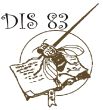
Acosta, M.,1 and B. Goñi. 2000. A technique for collecting and examining a large number of eggs. Dros. Inf. Serv. 83: 174-175.
|
|
|
|||
A technique for collecting and examining a large number of eggs.
Acosta, M.,1
and B. Goñi. Facultad de Ciencias, Universidad de la República, Montevideo,
Uruguay. 1Present address: Graduate
School of Environmental Earth Science Hokkaido University, Monbusho-yochi, Kita 10, Nishi 5, Kita-ku,
Sapporo, Hokkaido, Japan. FAX:
(0081) 11 7062225. e-mail: monica@ees.hokudai.ac.jp
When examining egg hatchability in relation to the genetic background and age of the parental flies, it is necessary to examine a large number of eggs and also to minimize factors that may affect the egg hatchability. It is known that the availability of food affects the female fecundity (David et al., 1971), so it is important to keep the parental flies well fed during the egg collection period. In this communication, we present an easy way of manipulating flies and collecting their eggs without harassment. A disposable egg collection container made of a Blue MaxTM 50 ml polypropylene conical tube (30 mm diameter Falcon tubes, Becton Dickinson Labware) was adapted as follows: the tube is cut to its conical base and replaced by a “soft drink” plastic cap (only a few brands do not fit). The screw end of the tube is then sealed with a cotton or sponge cork. The plastic caps are partially filled with the agar-apple juice egg collection medium reported by Nüsslein-Volhard and Wieschaus (1986) to which Methylene blue or another vital stain is added to improve the visualization of the eggs. A few grains of dry yeast are also added to the medium before its solidification in the caps. When applying the yeast in this way, the grains are deep in the solidifying medium and do not become viscose, still allowing the visualization of the eggs. The females can be kept well fed during the egg collection period since the plastic caps can be replaced daily or at shorter intervals. For the collection or replacement of the plastic caps, the flies are gently shaken into the cork end of the tube. The eggs can now be collected from the medium with a thin needle and further incubated on humid paper placed in a chamber at 25°C (Roberts, 1986). We found it useful to count the eggs directly in the caps, and further incubate the caps in a humid Tupperware chamber at 25ºC. After 24 hours from the collection time, the eggs that have not hatched are examined under a stereomicroscope or microscope in a drop of Voltaleff oil to check the stage of death (Nüsslein-Volhard and Wieschaus ,1986).
References: Ashburner, M., 1989, In: Drosophila: A Laboratory Handbook, Cold Spring Harbor Press, pp.139-248; David, J.R., P. Fouillet, and M.-F. Arens 1971, Rev. Comp. Animal 5: 277-288; Wieschaus, E., and C. Nüsslein-Volhard 1986, Looking at embryos. In Drosophila: A Practical Approach, IRL Press, Oxford. pp. 199-287; Roberts, D.B., 1986, In Drosophila: A Practical Approach pp. 1-38.